AUCTION FINDS OF THE WEEK- SEPTEMBER 9th: ENGLISH & CONTINENTAL FURNITURE & DECORATIVE ARTS AT FREEMAN'S
by Kelly Keating on 09/09/14
Auction Finds of the Week returns with selections from the English & Continental Furniture & Decorative Arts auction to be held at Freeman's in Philadelphia on 7 October 2014. This week's picks include German, English, French and Dutch furniture as well as a single decorative arts lot of German porcelain which I could not resist. I hope my choices will inspire you in the design of your own space or spur you on to add vintage and antique items to your life. Antiques can be found at all price points and they are a wonderful addition to any space giving it character, history and a sense of time which is sometimes so lacking in our (post)postmodern digital world.
This week's first find is a massive piece of early 18th century Southern German furniture, a secretaire bookcase or shrank that stands an impressive 82" high. It is
lot 239 with a pre-sale estimate of $4,000-6,000. The shrank was a Baroque form that persisted well into the 18th century and particularly in Southern Germany. As is typical of the form, there is marquetry decoration of a basket of flowers on the upper level cupboard door. The whole piece is made of inlaid figured walnut that gives it a rich and dynamic surface. The shrank consists of two sections. The upper section has an arched molded cornice above a central cupboard door with marquetry inlay of a basket of flowers with a bank of five drawers on either side. The lower section has a fall front desk on which is centered an inlaid armorial cartouche in ivory depicting an eagle above an oval incorporating three powder horns. What a great detail! The fall front desk is over three long drawers and the whole is raised on bun feet. It will be interesting to see how this gigantic piece fares at the auction as most people simply do not have the room for something of this size. Despite its size drawbacks, it is a splendid example of its type. There is a wonderful contrast between the intricacy and dynamism of the inlaid surface and the monumental, sculptural form of the whole.
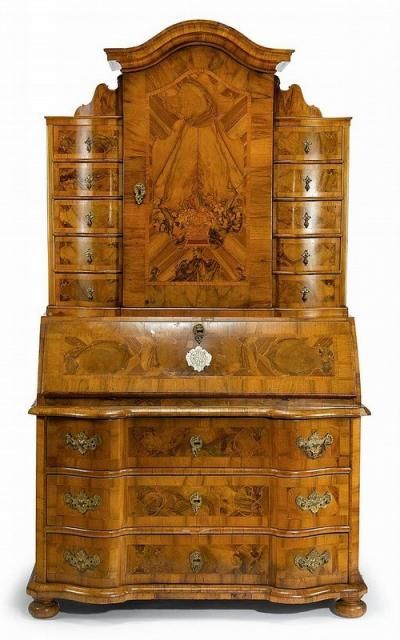
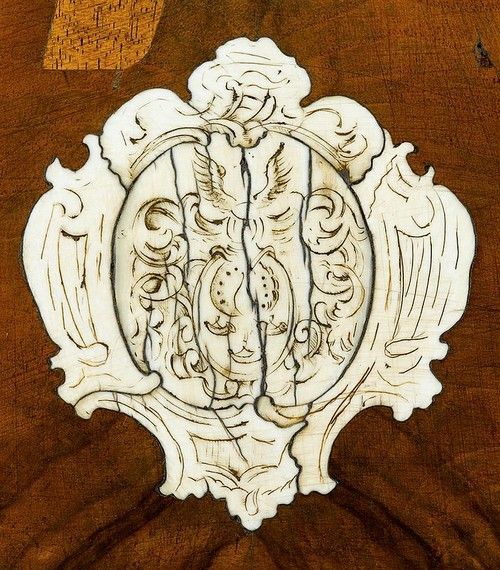
This week's next discovery is a Dutch mid-18th century walnut bombe commode- lot 255, with a pre-sale estimate of $2,000-3,000. This commode is a late Rococo piece with a shaped burl walnut top with molded edge over four cockbeaded long graduated drawers and a deep shaped skirt. The whole stands on hairy claw and ball feet. The oversized hairy claw and ball feet of this commode are typical of late Rococo furniture in The Netherlands and give the piece a solid planted look. Why not design a whole room around this chest letting it be the focal point? You could mix in modern elements with it as well to create a rich and satisfying look.

This week's third treasure is a George III mahogany bowfront secretaire chest on chest from the early 19th century- lot 192 with a pre-sale estimate of $4,000-6,000. Like the shrank, this English chest on chest is a massive piece of furniture standing 85" tall. Not only is it a chest on chest, but the top drawer of the lower section opens to reveal a hidden desk. What a wonderful feature! The piece stands in two sections. The upper section with a cornice centered by a crest of a sheaf of wheat flanked by rosettes. The ends of the cornice have rosette carved corners surmounted by ball and spire finials over an arcaded dental frieze which is above two short drawers and three long cockbeaded drawers. The secretaire drawer opens to reveal a writing surface with an arrangement of drawers and pigeon holes. Below this drawer are two further long drawers. The whole stands on splayed bracket feet. What a superb piece of furniture for a large bedroom! The secretaire drawer would be quite practical and could support a laptop for managing one's household. Yet, this is large item of furniture that would not be easily accommodated in most living spaces, so it will be interesting to see how it fares at the auction.
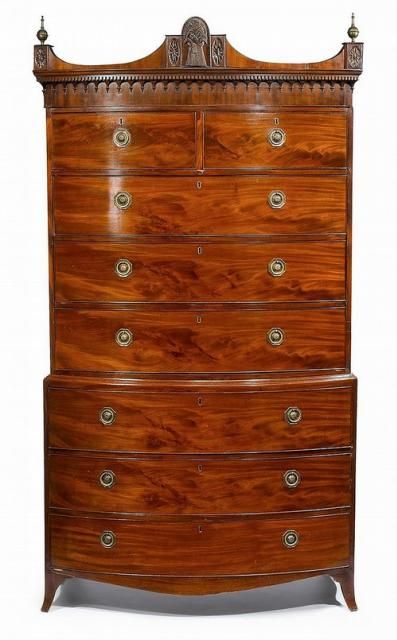
This week's next find I chose as a constructive example rather than a piece of furniture that I would want in my own home. Lot 320 is a Louis XVI style gilt bronze mounted kingwood and tulipwood marquetry and parquetry inlaid commode with a marble top from the late 19th/early 20th century with a pre-sale estimate of $20,000-30,000. As I have mentioned in other posts before, whenever you see the word "style" in an auction listing, it usually means the piece is emulating a certain period, but is not in actuality from that particular period. Lot 320 is a Louis XVI style commode but it is not from the 18th century. In the late 19th century and early 20th century, there was a revival of 18th century furniture styles in France. In part this resurgence had to do with a nationalistic response to the humiliating defeat that France suffered in the Franco-Prussian War of 1870-71. Many of these "reproductions" are superb, but I don't think this one at Freeman's can be classified with those examples. Look at it closely particularly the mounts and see what you think and if you would pay $20,000-30,000 for it. And if you want to see some really gorgeous period 18th century French furniture visit here.
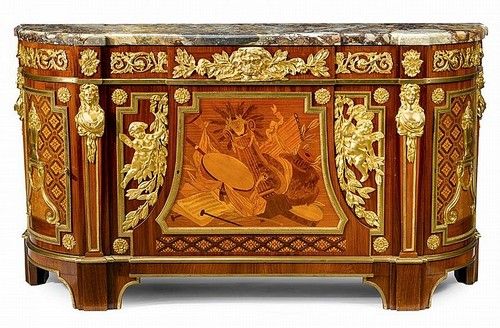
This week's last furniture lot is a sweet George I slant front inlaid walnut desk from the early 18th century- lot 136 with a pre-sale estimate of only $1,500-2,500. This desk looks like it has had a long hard life, but I think it is quite charming and I would have it in my house in a hot minute. The drop down writing surface opens to reveal an arrangement of pigeonholes and drawers along with two document slides flanking a door. The desk is above two short and three long graduated cockbeaded drawers. The bottom drawer has a lovely radially veneered cut-out which I think in many ways makes the desk. The whole is raised on bracket feet. I think slant front desks should make a comeback. They pretty much fell out of favor with the advent of computers. But today, with laptops and wireless connections, I think, they would be very functional. After you are done using your laptop or tablet, just slip the it into one of the drawers until the next time you use it. And when company arrives just close up the desk and everything looks neat and tidy.
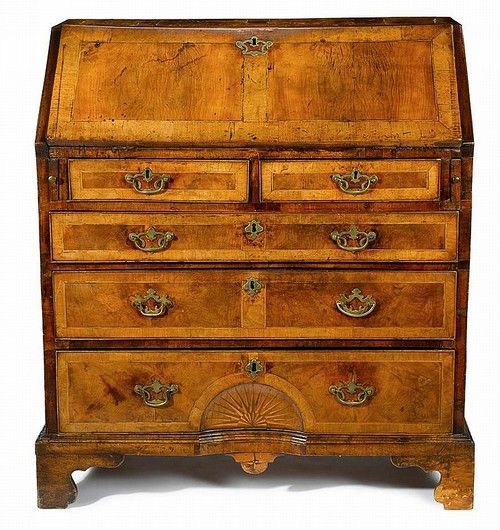
This week's final lot is German porcelain and not a piece of furniture, but I couldn't resist this fabulous pair of KPM gilt porcelain covered ice pails, lot 353, in the Empire style and dating to the early 19th century. They have a pre-sale estimate of $2,000-3,000. Each pail is cylindrical in shape and surmounted by covers supporting a pine cone finial which is in turn encircled by a decorative border of acanthus leaves, an egg and dart motif and foliage on a green ground. Under the cover rim on the body of the ice pails there is a rosette and bull's head border also on a green ground that is above six rosette ring pulls. Below the ring pulls is a ring of acanthus leaf and floral decoration along with a Greek key border. The pails are supported on three winged monopodia feet with female figures. These ice pails demonstrate how the Empire style moved beyond France, not only to areas conquered and controlled by Napoleon, but also to countries who were his enemies like Prussia where the KPM factory was located. At almost 12" high and 6.5" in diameter, this pair of Empire ice pails would be fantastic on a mantel or a sideboard or part of a dining room tablescape. Or even use them for their original purpose on a swank bar. I think they are just fab!
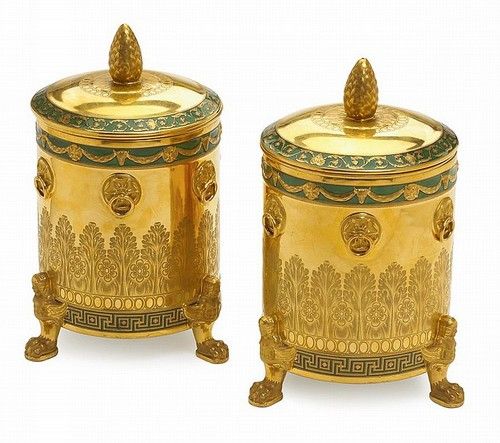
I hope this week's discoveries will provide inspiration for the design of your own space or stimulate your desire to collect antiques and mix them with more modern elements in order to create a more spirited room that combines old and new. If you are looking for an antique or vintage piece of furniture, porcelain, glass etc., I can help. Check out the Services Page on my website to see how I work with clients helping them find a new object for their home. Also, if you need help selling your antiques I can assist you as well. In addition, I am also available for insurance or inventory appraisals. Again take a look at the Services Page on my website.
Until next time,
Kelly T Keating
Comments (0)
